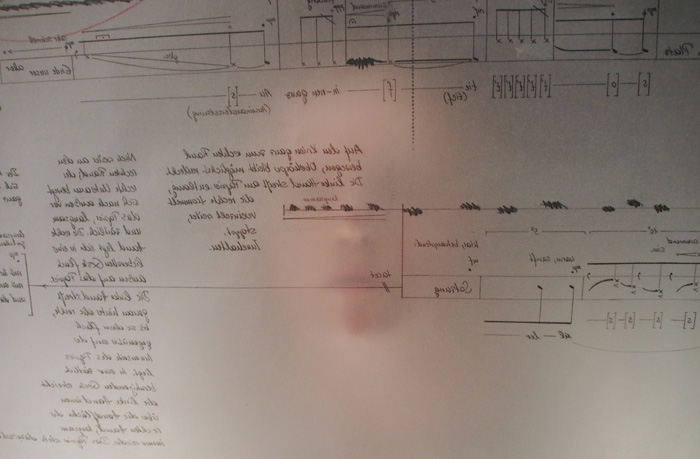Notation as an intermediary zone
Looking into a conception of the intermediary, I carried out research into Donald W. Winnicott's theories about a transitional zone as a location for ‘playing and doing’. The pioneering British psychologist, following his observations of babies in relation to their mothers, postulated a ‘potential space’, the area of play, as a third area between baby and mother/parent (or: child and family, individual and society). This intermediate ground, which from an individual’s point of view is neither ‘inside’ one’s personality nor ‘outside’, but accessible from both sides, provides space for individual experiences. From here, play expands into creative living and cultural activity (Winnicott, 2005).
The concept of a third area as a place and time for the activity of inquisitive exchange and creativity clarifies certain aspects of my compositional process, most of all the role of notation. My music is generated from an inner urge, and not geared towards production or the dramatic. In composing, I work with structures and geometries of perception. I include my own thinking activity, which requires a fine-tuned personal awareness of inner states. Imagination and first thoughts leading to the conceptual ground of a composition originate from a central space deep within the/my ‘inner’ world. Winnicott claims that the core of a personality is fundamentally isolated, rests in silence and does not communicate; from the quietness, communication with the ‘outside’ arises. The innermost reality may be characterised by the wish not to be found (Winnicott, 1972, pp. 179-192). From this hidden origin, the process of notating a composition is long and intense for me; it activates creativity and is accompanied by considerable struggle at the same time. I do not experience it as a translation process, i.e. a transfer of content from one system to another similar system; it seems to bring about a radical shift in paradigms. For me, notation is a key phase which extends the inner, compositional process into performance.
(photo by Pia Palme).

I experience this phase as a domain of its own, located neither ‘inside’ nor ‘outside’. Drawing on Winnicott, I would define it as an intermediate zone - together with its manifest objects, i.e. the first sketches of notation, up to the score for performance as its final product. This area and its phenomena simultaneously contrast with and join the immediate, personal reality of my ‘inside world’ and the common property of the ‘outside reality’. While the latter is more objectively perceived, and open to others, the inner core remains isolated and hidden. In my highly personal approach to composition, notation is the intense working process of constructing a bridge from true isolation to common ground. Winnicott’s explanations help to understand the complexity of this work, and also clarify my ongoing discontent with standard forms of notation. In my creative process, notation is an intermediary which requires openness and a space of its own; mechanised and standard forms of score writing can barely serve as tools here.
The function of objects in my recent pieces is to invite playfulness into the domain of notation. Haptic textures increase physical awareness; they invite the outer reality. In my work, objects are neither dramatic enhancements, nor added for scenic effect. I select objects from conceptual principles only. During the experimental phase, there is a process of feedback from both sides, the inner and the outer reality. The role of feedback is highly important: substantial exchange is a necessary ingredient, in fact the mingling of outer and inner keeps the creative process going. This may also include communication with performers. Only if experiments with an object are satisfactory, and everything fits into the final compositional structure, do I integrate an object into a piece. I immediately chose paper as a material for SETZUNG 1.1: paper is an ordinary material with good haptic and sonic qualities; it has been used for writing and composing for centuries; it may also be folded and modelled; it is cheap and easily available and it is environmentally-friendly. I started to work on a performance concept which would synchronise vocal production and movements on paper.
